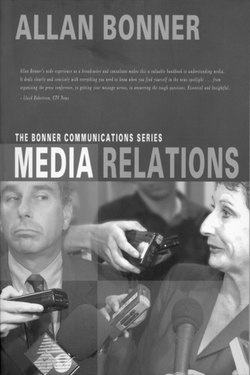Читать книгу The Bonner Business Series â Media Relations - Allan Bonner - Страница 16
На сайте Литреса книга снята с продажи.
Overriding
ОглавлениеThe average human ear connected to the average human brain takes in just 35% of what it hears. The amount remembered after one week is just 10%. It might even be less with busy reporters who are hearing lots of “spin” on any given day.
You have to make a special effort to get reporters to listen to you and understand what you’re saying.
The first thing you must do is identify and gather all the various messages you intend to deliver. Write them down. Then try to visualize this mass of information you have gathered to be in the shape of an iceberg.
The most important information you want to convey is like the tip of the iceberg — only 10% of all the information you have on your subject. This is the equivalent of the reporter’s lead, except it’s your perspective on the issue, not the reporter’s.
Imagine you are on a bus and a passenger says to you: “I notice from your briefcase that you’re with XYZ Corporation. Didn’t I read something bad about your company recently? What’s going on?”
Your questioner then pulls the signal to indicate he wants to get off at the next stop. You have 8 seconds to tell that person the most important things you know about your organization.
If your questioner decides to stay on the bus to hear more, you can reinforce your message by delivering the next most important 10% of your information, and so on.
In Hollywood, it’s called your “elevator pitch.” You enter an elevator and press number 20 when someone else enters and presses number 10. It turns out to be a famous producer and you have only a few seconds to pitch your movie idea before he gets off and vanishes. It had better be good. That’s where the SOCKO system comes in.
The SOCKO system is similar to the way newspaper stories used to be prepared in the days before newsrooms were computerized and printing presses still used hot type.
Reporters working on a story near deadline would type their copy on short pieces of paper that would hold only a few sentences. Then the reporter would yell, “Copy!” to summon a copy boy who’d take those few sentences to the editor’s desk for checking before they could be sent down to the composing room for inclusion in the newspaper.
This process continued until either the story was complete or, more likely, the clock ran out and the composing room advised that the page was “locked” and the paper had been “put to bed.” Because of the danger of running out of time, reporters would put the most important facts at the top of the story. Besides, readers often stop reading before they get to the end of a story. That’s the reason for the inverted pyramid structure for print stories. It would take extraordinary circumstances for the editor to “stop the presses” so that new information could be included.
SOCKOs, and the gradual and sequential release of them in order of importance is the spokesperson’s equivalent of the reporter typing on deadline. The analogy continues because at any moment in your journalistic encounter, the reporter might say “thank you,” and your opportunity is over. In this environment, you need brevity, clarity, simplicity and your most important messages on the tip of your tongue.
